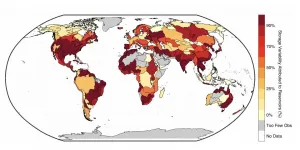(Press-News.org) At the beginning of an immune response, a molecule known to mobilize immune cells into the bloodstream, where they home in on infection sites, rapidly shifts position, a new study shows. Researchers say this indirectly amplifies the attack on foreign microbes or the body's own tissues.
Past studies had shown that the immune system regulates the concentration of the molecule, sphingosine 1 phosphate (S1P), in order to draw cells to the right locations. The targeted cells have proteins on their surface that are sensitive to levels of this molecule, enabling them to follow the molecule's "trail," researchers say. S1P concentration gradients, for instance, can guide immune T cells to either stay in lymph nodes, connected glands in which these cells mature, or move into blood vessels.
For the first time, researchers at NYU Grossman School of Medicine showed in mice experiments that S1P levels in lymph nodes increase as the immune response mounts. Such activation of immune cells can cause inflammation, swelling, and/or death of targeted cells.
While past work had shown that S1P is produced by cells attached to lymph nodes, the new study found that monocytes, circulating immune cells, also produced it when mice were infected with a virus. This in turn may influence the migration of T cells, a set of white blood cells that expands rapidly in response to infection, say the study authors.
Publishing in the journal Nature online March 3, study results showed that T cells left mouse lymph nodes less than half as fast when S1P levels rose, while mostly immature cells escaped when S1P levels were not spiking.
"Our research shows a larger role for sphingosine 1 phosphate in coordinating immune defenses in response to infection and inflammation," says study lead investigator Audrey Baeyens, PhD, a postdoctoral fellow at NYU Langone and its Skirball Institute of Biomolecular Medicine. "While further testing is needed, our findings raise the prospect of controlling levels of S1P to either boost or diminish the body's immune response, as needed."
Moreover, the researchers found that when lymph node levels of S1P went up, it signaled T cells to remain in lymph nodes. Such "trapped" T cells, with longer time to mature and become fully armed in the node, increase in their toxicity. These mature T cells can attack cells infected by viruses, or healthy cells as part of autoimmune diseases.
Indeed, medications that block S1P, preventing immune cells from leaving the lymph nodes, are used to curb unwanted and autoimmune inflammation related to inflammatory bowel disease, psoriasis, and multiple sclerosis, a disease for which fingolimod (Gilenya) is one of the few approved treatments.
Researchers say their findings could also explain why multiple sclerosis patients can experience severe disease relapse immediately after ceasing fingolimod treatment, as T cells held long in lymph nodes are then freed to attack the body's nerves, a key trait of the disease.
"Now that we have a better understanding of sphingosine 1 phosphate inhibition, we can work on finding new uses for this class of medications, perhaps by manipulating the time T cells spend in the lymph nodes," says study senior investigator Susan Schwab, PhD. Schwab is an associate professor in the Department of Pathology at NYU Langone and Skirball.
For the study, S1P levels were measured in mice bred to develop symptoms of multiple sclerosis, a disease involving severe inflammation of the brain and spine. They also measured S1P levels in mice exposed to viral genetic material to mimic the inflammation that occurs in infection.
Schwab says the team next plans to study how different S1P levels affect T cell maturation, and how these different maturation times strengthen or weaken the overall immune response to infection.
INFORMATION:
Funding support was provided by National Institutes of Health grants R01 AI085166, R01 AI123308, P30 CA016087, and S10 RR023704.
Besides Baeyens and Schwab, other NYU Langone researchers involved in this study are Sabrina Bracero, BS; Venkata Chaluvadi, BS; Alireza Khodadadi-Jamayran, MS; and Michael Cammer, MFA, MAT.
Media Inquiries:
David March
212-404-3528
david.march@nyulangone.org
New research shows 64 countries cut their fossil CO2 emissions during 2016-2019, but the rate of reduction needs to increase tenfold to meet the Paris Agreement aims to tackle climate change.
This first global stocktake by researchers at the University of East Anglia (UEA), Stanford University and the Global Carbon Project examined progress in cutting fossil CO2 emissions since the Paris Agreement was adopted in 2015. Their results show the clear need for far greater ambition ahead of the important UN climate summit in Glasgow in November (COP26).
The annual cuts of 0.16 billion tonnes of CO2 are only 10 ...
SPOKANE, Wash. - The researchers' findings showed that participants who were given A low-cost, easy-to-administer intervention that uses small prizes and other incentives to reward alcohol abstinence can serve as an effective tool to reduce alcohol use among American Indian and Alaska Native communities, new research suggests.
Published today in JAMA Psychiatry, the study tested a culturally adapted version of an intervention known as contingency management in American Indian and Alaska Native adults diagnosed with alcohol dependence, a severe form of ...
During the COVID-19 pandemic in 2020, there was a 34% increase in alcohol withdrawal (AW) rates among hospitalized patients at ChristianaCare, according to a research letter published today in the Journal of the American Medical Association.
The study is believed to be the first to quantify the impact of the COVID-19 pandemic on alcohol withdrawal among hospitalized patients.
The retrospective study conducted at ChristianaCare, one of the largest health systems in the mid-Atlantic region, found that the rate of alcohol withdrawal in hospitalized patients was consistently higher in 2020 compared to both 2019 and the average of 2019 and 2018.
"Our findings are relevant nationally and serve as a clarion call to alert ...
What The Study Did: Whether alcohol withdrawal rates among hospitalized patients with alcohol use disorder increased during the COVID-19 pandemic was examined in this study.
Authors: Ram A. Sharma M.D., of Christiana Care in ,Newark, Delaware, is the corresponding author.
To access the embargoed study: Visit our For The Media website at this link https://media.jamanetwork.com/
(doi:10.1001/jamanetworkopen.2021.0422)
Editor's Note: The article includes conflict of interest and funding/support disclosures. Please see the article for additional information, including other authors, author ...
What The Study Did: Researchers in this randomized clinical trial examined the effectiveness of incentives offered for laboratory-confirmed abstinence from alcohol among American Indian and Alaska Native adults diagnosed with alcohol dependence.
Authors: Michael G. McDonell, Ph.D., of Washington State University in Spokane, is the corresponding author.
To access the embargoed study: Visit our For The Media website at this link https://media.jamanetwork.com/
(10.1001/jamapsychiatry.2020.4768)
Editor's Note: The article includes conflict of interest and funding and support disclosures. Please see the article for additional ...
What The Study Did: This study combined the results of 27 studies with 10,000 participants to investigate the association between cardiovascular risk factors such as diabetes and high blood pressure and cognitive impairment in people with schizophrenia.
Authors: Christoph U. Correll, M.D., of the Zucker Hillside Hospital in Glen Oaks, New York, is the corresponding author.
To access the embargoed study: Visit our For The Media website at this link https://media.jamanetwork.com/
(10.1001/jamapsychiatry.2021.0015)
Editor's Note: The article includes conflict of interest ...
Water levels in the world's ponds, lakes and human-managed reservoirs rise and fall from season to season. But until now, it has been difficult to parse out exactly how much of that variation is caused by humans as opposed to natural cycles.
Analysis of new satellite data published March 3 in Nature shows fully 57 percent of the seasonal variability in Earth's surface water storage now occurs in dammed reservoirs and other water bodies managed by people.
"Humans have a dominant effect on Earth's water cycle," said lead author Sarah Cooley, a postdoctoral scholar ...
Researchers from Bremen, together with their colleagues from the Max Planck Genome Center in Cologne and the aquatic research institute Eawag from Switzerland, have discovered a unique bacterium that lives inside a unicellular eukaryote and provides it with energy. Unlike mitochondria, this so-called endosymbiont derives energy from the respiration of nitrate, not oxygen. "Such partnership is completely new," says Jana Milucka, the senior author on the Nature. "A symbiosis that is based on respiration and transfer of energy is to this date unprecedented".
In general, among eukaryotes, symbioses ...
An international research group led by the University of Basel has developed a promising strategy for therapeutic cancer vaccines. Using two different viruses as vehicles, they administered specific tumor components in experiments on mice with cancer in order to stimulate their immune system to attack the tumor. The approach is now being tested in clinical studies.
Making use of the immune system as an ally in the fight against cancer forms the basis of a wide range of modern cancer therapies. One of these is therapeutic cancer vaccination: following diagnosis, specialists set about determining which components of the tumor could function as an identifying feature for the immune system. The patient is then administered ...
The universe was created by a giant bang; the Big Bang 13.8 billion years ago, and then it started to expand. The expansion is ongoing: it is still being stretched out in all directions like a balloon being inflated.
Physicists agree on this much, but something is wrong. Measuring the expansion rate of the universe in different ways leads to different results.
So, is something wrong with the methods of measurement? Or is something going on in the universe that physicists have not yet discovered and therefore have not taken into account?
It could very well be the latter, according to several physicists, i.a. Martin S. Sloth, Professor of Cosmology at University of Southern Denmark (SDU).
In a new scientific article, he and his SDU ...


